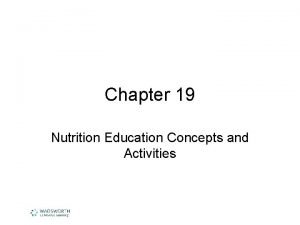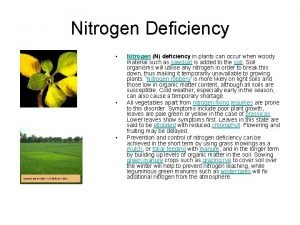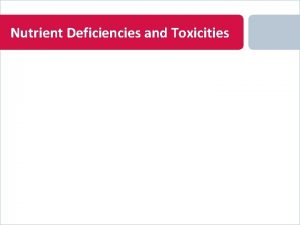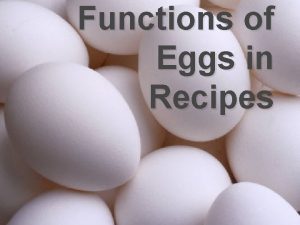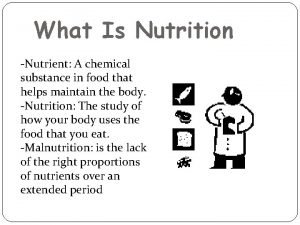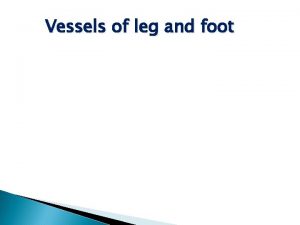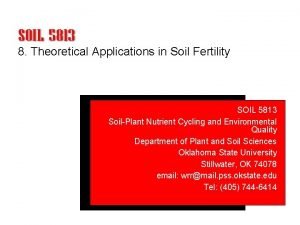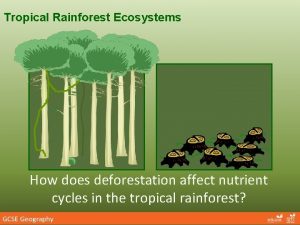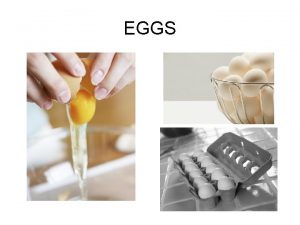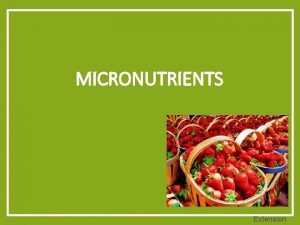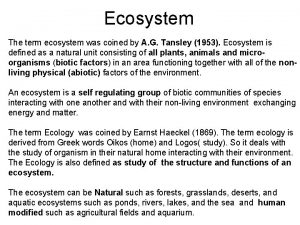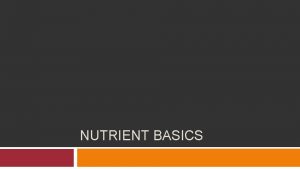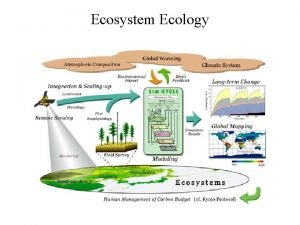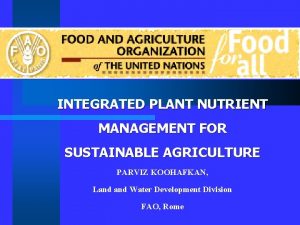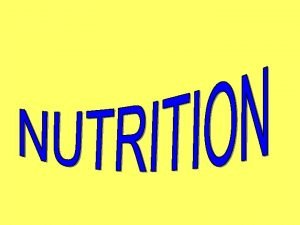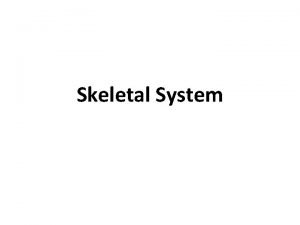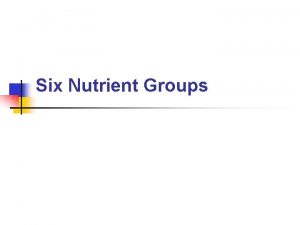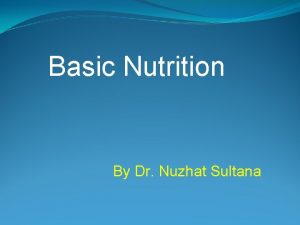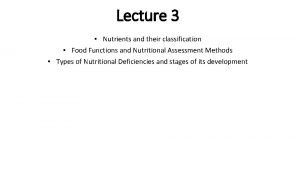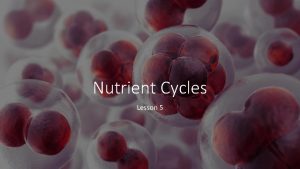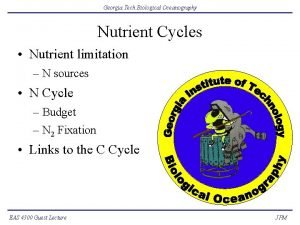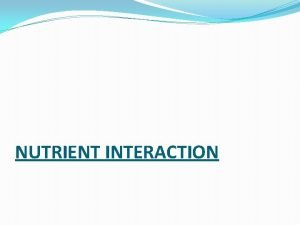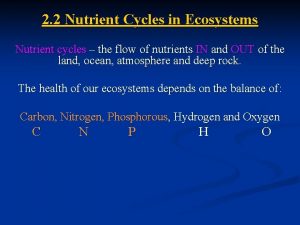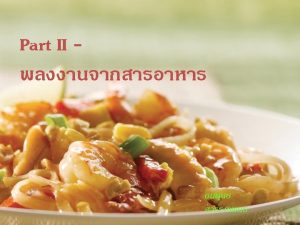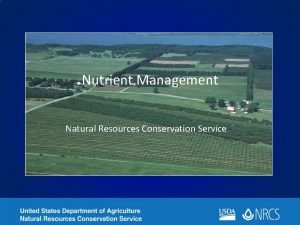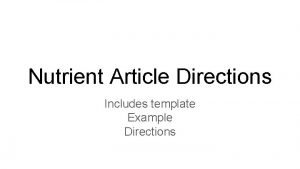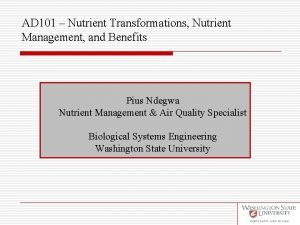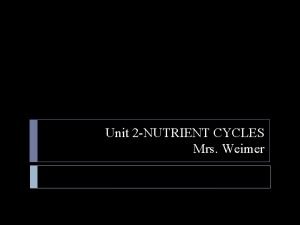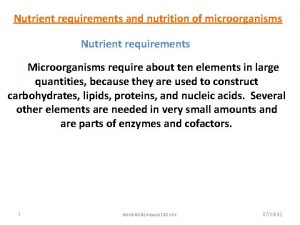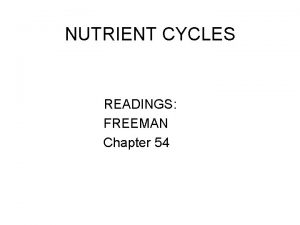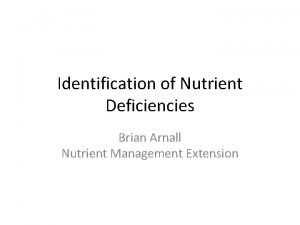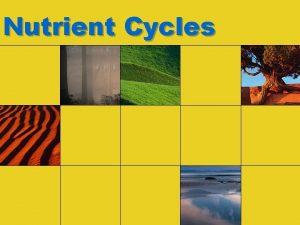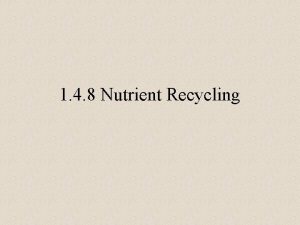What is a Nutrient A nutrient is a


























- Slides: 26

What is a Nutrient? • • A nutrient is a chemical substance in food that helps maintain the body. You need over 50 nutrients, which can be divided into six groups. Water Carbohydrates Lipids (Fats) Proteins Vitamins Minerals 1

The Six Classifications of Nutrients • Water • Carbohydrates • Fats • Protein • Vitamins • Minerals Sugars Starches Cellulose 2

These Nutrients Have Calories • Proteins • Carbohydrates • Fats 3

Definition of a Calorie: • The unit used to measure the energy value of food. 4

Calories per gram: • • • Protein 1 Gram = 4 calories Carbohydrates 1 Gram = 4 calories Fat 1 Gram = 9 calories 5

Variables which affect nutrient needs: 1. Age 2. Gender 3. Activity Level 4. Climate 5. Health 6. State of nutrition 6

Key Nutrient: Water 7

Function • • Aids digestion and cell growth and maintenance Facilitates chemical reactions Lubricates joints and cells Regulates body temperature 8

Sources • • • Liquids Food Breakdown of energy nutrients 9

Key Nutrient: Carbohydrates 10

Function • • • Supplies the energy Provides fiber Help the body digest fats 11

Sources • • • Sugars (Simple): honey, jam, molasses, candy, table sugar Fiber: fruits, vegetables, whole grains Starch(Complex): breads, cereals, pasta 12

Key Nutrient: Fats 13

Function • • • Supply energy Carry fat-soluble vitamins Insulate the body Protect organs Provide essential fatty acids 14

Sources Types of Fats • Saturated: dairy products, meats, lard, coconut and palm oils • Unsaturated: fish, nuts, vegetable oils 15

Cholesterol • The fat-like substance in found in body cells. This substance clogs arteries. 16

Key Nutrient: Proteins 17

Functions • • Builds and repairs muscles and cell tissues Helps the body make important substances Regulates body processes Supplies energy 18

Sources Complete proteins: • dairy products, eggs, fish, meat and poultry. Incomplete proteins: • beans, grains and nuts. 19

Key Nutrient: Vitamins 20

Function Vitamins are divided into two main groups. Fat-soluble vitamins • dissolve in fats • are stored in fatty tissues of the body Water-soluble vitamins • dissolve in water • are not stored in the body 21

Fat-Soluble Vitamins Nutrient Functions Sources Vitamin A Keeps skin and mucus membranes Butter, dark green and yellow fruits healthy and vegetables, egg yolk, liver, whole and fortified milk Prevents night blindness Promotes growth Vitamin D Builds strong bones and teeth Egg yolk; fortified butter, margarine, and milk; the sun Vitamin E Acts as an antioxidant to protect cell membranes Eggs, liver, salad oils, whole grain cereals Vitamin K Helps blood clot Cauliflower, egg yolk, organ meats 22

Water-Soluble Vitamins Nutrient Functions Sources B-Complex Helps wounds heal Helps fight infection Helps nervous tissue function healthy Plays important role in breakdown of proteins fats and carbohydrates Oranges, grapefruits, tangerines, cantaloupe, broccoli, citrus fruits, tomatoes and raw cabbage Vitamin C (ascorbic acid) Keeps nervous system healthy Pork, whole grain breads and cereals Releases energy from food Helps promote healthy gums and tissues 23

Key Nutrient: Minerals 2424

Minerals Nutrient Functions Sources Calcium Builds bones and teeth Helps muscles and nerves work Milk, yogurt, cheese, salmon, dark veggies Iron Combines with protein to make hemoglobin. Helps cells use oxygen Liver, spinach, raisins and molasses Potassium Helps nerves and muscles Balances body water Potatoes, bananas, prune juice and tomato products Sodium Helps nerves and muscle function Salt, soy sauce, processed foods and country ham Iodine Promotes normal functioning of the thyroid gland Iodized salt and salt water fish 25

Food For Thought Avoid excesses of some vitamins and minerals. To promote good nutrition and maintain good health: • Eat a variety of foods from the food guide pyramid. • Drink plenty of water • Daily exercise • Seek the advice of a physician or dietician before taking supplements 26
 Medium
Medium Foods used in nutrition activities should be nutrient-dense
Foods used in nutrition activities should be nutrient-dense Wrist joint blood supply
Wrist joint blood supply What nutrient cushions vital organs
What nutrient cushions vital organs Gersmehl diagrams
Gersmehl diagrams Nutrient deficiency in tomatoes
Nutrient deficiency in tomatoes Nutrient deficiency
Nutrient deficiency Journey 2050 student handout 3 crossword puzzle
Journey 2050 student handout 3 crossword puzzle Emulsion eggs
Emulsion eggs Nutrition body
Nutrition body Posterior tibial artery
Posterior tibial artery Bray nutrient mobility concept
Bray nutrient mobility concept Nutrient cycle of a tropical rainforest
Nutrient cycle of a tropical rainforest Egg cooking style
Egg cooking style Nutrient interactions
Nutrient interactions Concept of ecosystem is coined by
Concept of ecosystem is coined by Nutrient basics
Nutrient basics Nutrient cycle in the serengeti
Nutrient cycle in the serengeti Integrated nutrient management for sustainable agriculture
Integrated nutrient management for sustainable agriculture What is fat made of
What is fat made of Parts of a long bone
Parts of a long bone Energy in trophic levels
Energy in trophic levels Six nutrient groups
Six nutrient groups Energy flow trophic levels
Energy flow trophic levels Immobile nutrients
Immobile nutrients Defination of nutrition
Defination of nutrition Classification of nutrient
Classification of nutrient

